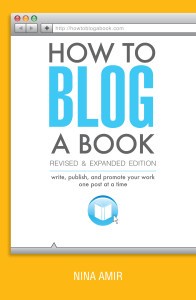By Nina Amir, @NinaAmir
I know few writers who feel they have enough time to work on their books. Most tell me they want to be more effective and productive because they need to promote their books as well as write them. That’s why I developed the blog-a-book strategy. It allows you to write, publish and promote a book all at the same time.
As you intentionally publish the first draft of your book post by post on your blog, you effectively build a readership for that work. You develop a group of loyal fans ready and willing to purchase the final edition when you release it in print or digital version.
If you’d like to work smarter, not longer and harder, and write a book on your blog—or as you blog, follow these basic steps to plan out your nonfiction or fiction blogged book.
Your Blog-a-Book Plan
Once you have the topic or storyline for your book, it’s time to determine the contents of your book. In the initial stages of blogging a book, this is not that much different than planning a book you write the “normal” way.
1. Brainstorm your book’s content.
Begin with a brainstorming activity. Allow yourself to consider all the possible content or story lines your book could include. You can do this with a mind map. If you prefer, use an outline. Novelists and memoirists often like a timeline for this exercise.
Think about all the subjects, research, characters, facts, scenes, turning points, life events, etc., you might want to include. Produce a brain dump of ideas.
2. Create a table of contents.
When you are done brainstorming the subjects and stories that you will include in your manuscript, organize that content into a table of contents. Give your book structure by turning the mish-mash of ideas into chapters that flow from one to the next logically.
To do this, you need to create your novel’s story line or determine the best sequence for the information that will comprise your nonfiction book. Find the major life events to include in your memoir.
3. Plan Your Posts
Next, break down the content you have planned for each chapter of your book into post-sized bits. Publish each one of your chapters on your blog in 300-700-word pieces—blog posts. To make this easier, create a blog plan. Turn what normally would be many long chapters (each one several thousand words in length) into numerous short posts.
If you write nonfiction, think of each blog post as a subtopic or a subheading in your chapter. Create 15 to 20 subheadings (or posts) per chapter. To adequately address some of these subtopics, you might need to write more than one post. Note these additional posts in your plan, possibly even with a blog post title.
When you finish, your blog-a-book plan might look like this:
If you write fiction, plan out the scenes in each chapter and break them into post-sized bits. You also might use longer bits of dialogue or description as individual posts. Each one of these small parts of your chapter gets turned into a blog post. (Sometimes your posts will be longer to accommodate a whole scene.)
I’m not a novelist, but to give you an idea of how your blog-a-book plan might look, here’s an example of one chapter with some of the details planned out as posts.
4. Create a blogging schedule.
Once you complete your plan, create a blog schedule. Decide how many days per week you will blog your book and stick to it. The more often you blog, the faster you gain readers. You also get your book written faster.
It’s better to publish shorter posts more often (especially when trying to build platform). Don’t publish 2,000-word posts once every two weeks. (Remember, you are not serializing your book.) Overly long and infrequent blog posting doesn’t attract readers and makes the book writing process feel harder. Plus, it will take longer. Blog your book in too short a period and you won’t attract many readers either.
To figure out how long it will take you to blog your book, determine the length of your book. Then divide this number by your average post length, for example, 500 words.
If you publish three posts per week, each one about 500 words long, and you write a 10,000+ e-book in seven weeks. Or publish 100 posts, each one about 500 words long, and you produce a 50,000-word manuscript. Publish posts three times per week, and you finish that manuscript in 34 weeks.
Publish more posts more often to finish your book faster. Or increase the length of your posts to complete in record time.
Final Tip
Before you plan your blogged book content and schedule, be sure your idea is marketable. I suggest going through the basic steps of evaluating an idea prior to writing. Do this by creating a business plan for your book that includes a market and competitive analysis. Use the information you gain to craft a book idea that targets your market and provides a unique and necessary offering in the appropriate bookstore category.
Complete all these steps and you are ready to write, publish and promote at the same time—to become a more effective and productive writer.
To learn more about blogging book and booking blogs, purchase a copy of How to Blog a Book Revised and Expanded Edition in the Writer’s Digest Shop.

Nina Amir, the Inspiration to Creation Coach, is the bestselling author of How to Blog a Book and The Author Training Manual. A speaker, blogger, and author, book, blog-to-book, and high-performance coach, she helps people combine their passion and purpose so they move from idea to inspired action and positively and meaningfully impact the world as writers, bloggers, authorpreneurs, and blogpreneurs. Some of Nina’s clients have sold 300,000+ copies of their books, landed deals with major publishing houses and created thriving businesses around their books. She is the founder of National Nonfiction Writing Month, National Book Blogging Month, and the Nonfiction Writers’ University. As a hybrid author, she has published 15 books and had as many as four books on an Amazon Top 100 list at the same time.
To find out more about Nina and get a free goal-achievement e-book, visit www.ninaamir.com. Receive a set of free blog-plan templates when you visit www.howtoblogabook.com or a free guide to writing a nonfiction book at www.writenonfictionnow.com.
Follow Nina on:
Twitter: https://twitter.com/NinaAmir
Facebook: www.facebook.com/InspirationToCreation
LinkedIn: https://www.linkedin.com/in/ninaamir
Pinterest: www.pinterest.com/ninaamir
Google+: https://plus.google.com/u/0/+NinaAmir/posts
Thanks so much for being a host for my blog tour, Elizabeth! I hope you readers find the post helpful.
Thanks for posting today, Nina! I especially love the part about creating a table of contents early on to help plan content.
I’ve been following Nina for years online and would also recommend everyone follow her blog at . Great info there, and not only for nonfiction writers.
Fascinating idea – I wish you’d gone into greater details, it feels like some of the stuff has been cut out though one can surmise what it probably was! I shall certainly purchase your book, Nina, and thanks Elizabeth for sharing.
Blogging a book, one you are willing to sacrifice, is a good way to build readership.
I blogged “A Long, Hard Look” and now it’s my bestselling book. I took it down a month after I finished it, and even folks who read the rough draft online have purchased the finished version.
No sacrifice required. In fact, the very opposite.
Elizabeth – Thanks for hosting Nina.
Nina – Thanks for your ideas about blogging a book. I can certainly see how a blogged book could invite readers to read one’s work. I may have to think about that…
Thanks so much for this guest post, Nina. I have a blog on my website, and it’s the subject of a non-fiction book I’ve started, but I’ve been careful NOT to overlap content. I based this on the assumption that a reader wouldn’t want to buy a book that was already available in some form for free.
But when I clicked over onto your website and started looking around, I’m now reconsidering. I read Joel’s testimonial above, and I can think of a book that I bought, despite the fact that it’s available in some form on the web. I bought it because I wanted all the information neatly packaged in one place, not because I couldn’t find it anywhere else for free.
This has given me a lot to think about–thanks.
Hi Elizabeth and Nina – yes I bought your book a few years ago … and our A-Z Challenge that we do … lends itself to your style of blogging a book – which is what I shall be doing. I’ll be coming back here and reading your book to help me through various parts and give me an overview of what I need to do …
A great guest Elizabeth – thank you … and to you too Nina – cheers Hilary